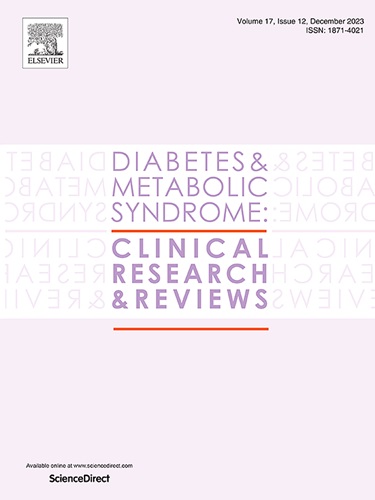胰高血糖素样肽-1受体激动剂、双GIP/GLP-1受体激动剂替西肽与自杀意念和行为:临床研究和药物警戒报告的系统回顾
IF 3.4
Q1 ENDOCRINOLOGY & METABOLISM
Diabetes & Metabolic Syndrome-Clinical Research & Reviews
Pub Date : 2025-04-01
DOI:10.1016/j.dsx.2025.103238
引用次数: 0
摘要
自杀是一个全球性的公共卫生问题,每年有近70万人死于自杀。虽然包括精神健康障碍在内的危险因素已被广泛认识,但关于胰高血糖素样肽-1受体激动剂(GLP-1 RAs)、双胃抑制多肽(GIP)/GLP-1受体激动剂替西肽与自杀行为之间的潜在关联的新担忧已经浮现。本系统综述旨在综合这些药物与自杀行为之间潜在关联的现有证据。方法本综述遵循PRISMA指南进行。系统检索MEDLINE、Embase和APA PsycInfo,截止到2024年9月24日,检索与GLP-1 RAs/GIP/GLP-1 RAs和自杀行为相关的术语。三位独立审稿人进行了文章筛选和数据提取。队列研究采用纽卡斯尔-渥太华量表评估偏倚风险,随机对照试验采用ROB2量表评估。结果本综述纳入2017年至2024年间发表的16项研究,包括5项观察性研究、2项随机对照试验、8项药物警戒分析和1项随机对照试验的事后分析。没有一致的证据表明GLP-1 RA服用者自杀风险增加。药物警戒分析产生了不同的结果;虽然一些歧化分析报告了相对于其他降糖药物较高的比例,但没有证实因果关系。涉及糖尿病和肥胖人群的队列研究一般没有显示自杀行为显著增加。结论:虽然目前的数据不能保证处方实践的改变,但在得出明确的结论之前还需要进一步的研究。此外,这些发现的普遍性和可靠性应根据纳入研究的方法学局限性来解释。本文章由计算机程序翻译,如有差异,请以英文原文为准。
Glucagon-Like Peptide-1 receptor agonists, dual GIP/GLP-1 receptor agonist tirzepatide and suicidal ideation and behavior: A systematic review of clinical studies and pharmacovigilance reports
Aims
Suicide is a global public health concern, accounting for nearly 700,000 deaths annually. Although well-established risk factors, including mental health disorders, are widely recognized, emerging concerns have surfaced regarding a potential association between glucagon-like peptide-1 receptor agonists (GLP-1 RAs), the dual Gastric Inhibitory Polypeptide (GIP)/GLP-1 Receptor Agonist tirzepatide and suicidal behavior. This systematic review aims to synthesize the available evidence on the potential association between these drugs and suicidal behavior.
Methods
This review was conducted following PRISMA guidelines. A systematic search was performed in MEDLINE, Embase, and APA PsycInfo up to September 24, 2024, using terms related to GLP-1 RAs/GIP/GLP-1 RAs and suicidal behavior.Three independent reviewers conducted article screening and data extraction. Risk of bias was evaluated using the Newcastle-Ottawa Scale for cohort studies and ROB2 for RCTs.
Results
The review identified 16 studies published between 2017 and 2024, consisting of 5 observational studies, 2 randomized controlled trials, 8 pharmacovigilance analyses, and 1 post-hoc analysis of RCTs. No consistent evidence indicated an increased suicide risk among GLP-1 RA users. Pharmacovigilance analyses produced mixed findings; while some disproportionality analyses reported higher rates relative to other antihyperglycemic drugs, no causal link was confirmed. Cohort studies involving diabetic and obese populations generally did not demonstrate a significant increase in suicidal behavior.
Conclusions
Although current data do not warrant changes in prescribing practices, further research is needed before definitive conclusions can be drawn. Moreover, the generalizability and reliability of these findings should be interpreted in light of the methodological limitations of the included studies.
求助全文
通过发布文献求助,成功后即可免费获取论文全文。
去求助
来源期刊

Diabetes & Metabolic Syndrome-Clinical Research & Reviews
ENDOCRINOLOGY & METABOLISM-
CiteScore
22.90
自引率
2.00%
发文量
248
审稿时长
51 days
期刊介绍:
Diabetes and Metabolic Syndrome: Clinical Research and Reviews is the official journal of DiabetesIndia. It aims to provide a global platform for healthcare professionals, diabetes educators, and other stakeholders to submit their research on diabetes care.
Types of Publications:
Diabetes and Metabolic Syndrome: Clinical Research and Reviews publishes peer-reviewed original articles, reviews, short communications, case reports, letters to the Editor, and expert comments. Reviews and mini-reviews are particularly welcomed for areas within endocrinology undergoing rapid changes.
 求助内容:
求助内容: 应助结果提醒方式:
应助结果提醒方式:


